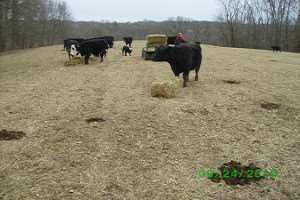By Chris Penrose
As I walk around the pastures this time of the year, especially with pasture growth slowing down and leaves falling off trees, I really notice what worked this year and what thing went wrong, and I also try to think of ways we can reduce tearing up our fields when we feed hay this winter. I also notice trends that may need to be addressed for next year before they get out of control. For example, for over 25 years, I had been mowing under my fencerows and I had been successfully controlling weeds. However, over the past 15 years, Autumn Olive has been growing and spreading along my fencerow. Whenever I mowed those plants, more would re-sprout. It got to the point where I could not see the fence in areas. This year, I felt like I was left with no choice but to use a herbicide on the fencerow. It worked very well. Another trend I saw this year was the spreading of Spotted Knapweed in pastures. If you do not have it, keep it out! From July through September, keep an eye out for the plants in your fields. If you see one, pull it up, put in a plastic bag, dispose of it, or burn it. One this year will become a hundred next year. They have been trying to invade my farm for the past four years and I have been pulling them up or spraying them along the road where they tend to get established. When I see some starting in my fields, I spray. I do think it is a battle I will lose over time and like many, may need to spray entire fields with a broadleaf herbicide at some point.

Fertility, Feeding, Seeding.
Can you notice other trends? For example, one of my paddocks has some poverty grass growing in it for the first time. That is a sign that I need to take a soil sample because my pH and phosphorus levels are low, probably very low. When you have a situation like this, it will take time to correct, so now is time to take soil samples and get the pH corrected before adding fertility. However, we can also help this process along. I had one field on my farm that was run down from mowing hay and for the past twenty years, I have fed hay in the field during the winter. Now the organic matter and fertility is way up and is very productive. If you have an area that needs to be improved, is feeding hay there an option? If you are feeding large round bales, can you move them out to the field before the weather turns bad, space them around twenty feet apart and utilize portable electric fence to allocate the hay as it is needed this winter? If you feed small square bales, can you feed hay this winter in those areas that need fertility?
When you feed hay out in a field in the winter, there is a strong chance that the soil may get exposed from the heavy livestock traffic and tractors. Is there a way that can be avoided? If you place the hay out before the weather turns bad or if you can place bales out when the ground is frozen, tractor damage to the soil can be avoided. If you can feed small square bales with an all-terrain vehicle, soil damage can be minimized. If you are able to consistently feed in different spots, damage can be minimized. If damage to the field becomes too severe, maybe a heavy use pad is a good option for you.
